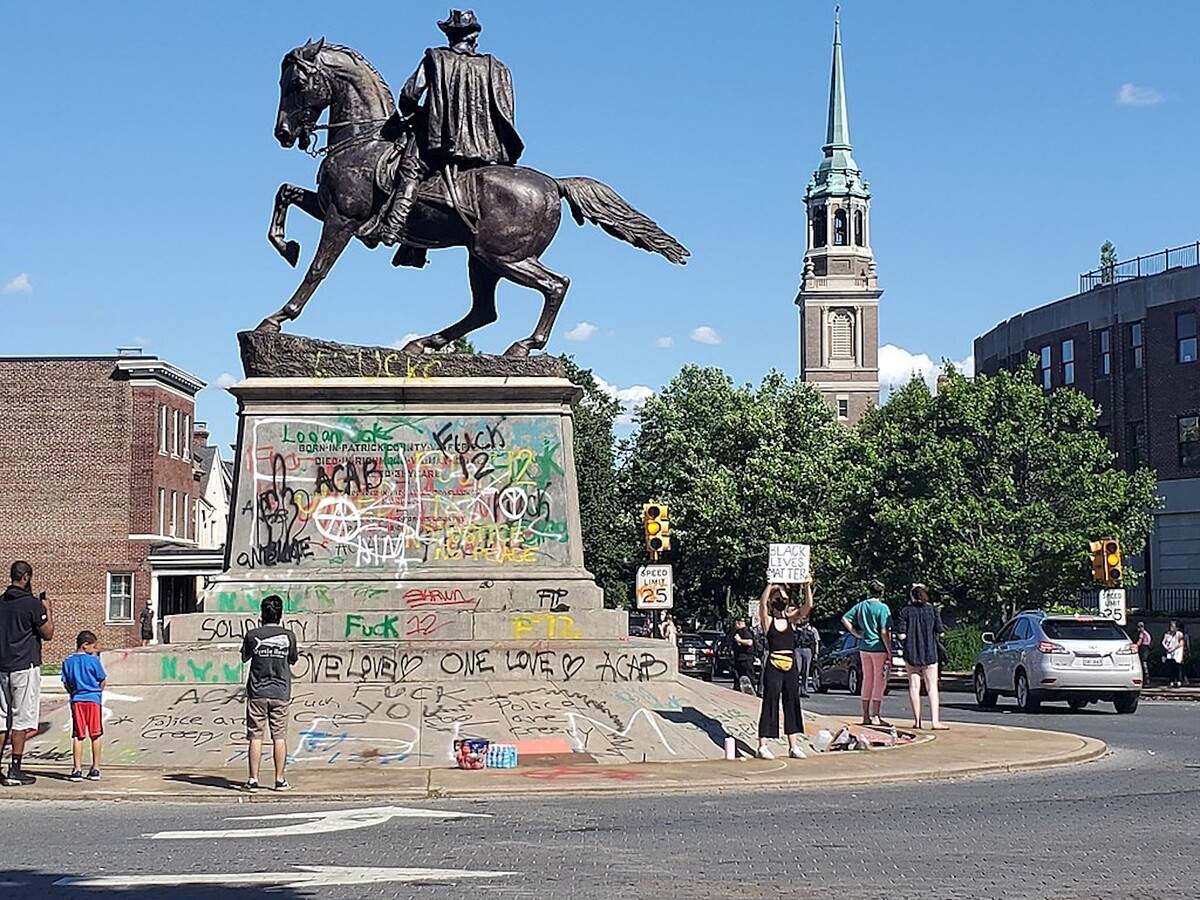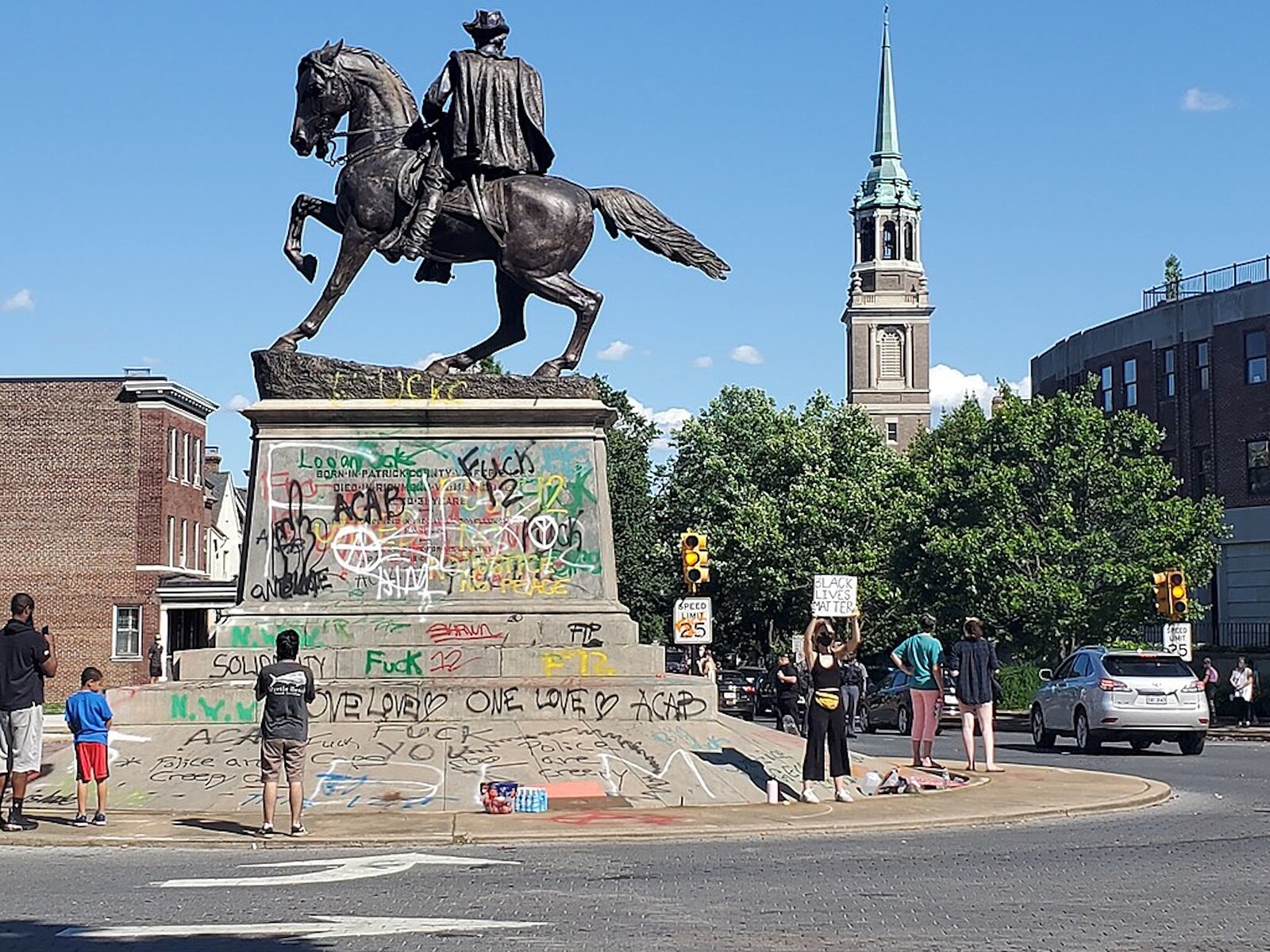Amid the waves of protests against the murder of unarmed black people by the police, many more US citizens began to question the validity of statues honoring men who massacred the continent’s indigenous inhabitants, owned slaves, and otherwise profited from the suffering, exploitation, and death of mostly non-European people. Some statues were successfully pulled down by crowds, others damaged, removed under the cover of night, and placed in storage. But most of these sculptures, as Erin L. Thompson documents in her much-needed history of public monuments and social change, have been legally protected in perpetuity by state legislatures. Take for example the Confederate Memorial Carving on Stone Mountain, which is the largest bas-relief sculpture in the world and depicts the heroes of the slave South Jefferson Davis, Thomas “Stonewall” Jackson, and Robert E. Lee as they ride toward something—possibly a future in which they exercise an inordinate influence. Thompson, a specialist in art crime, has written a thoroughly researched, convincing, and readable argument for the removal of the United States’ monuments to its colonial and slave history: in doing so, her book eradicates any lingering doubts as to the wisdom of suppressing these symbolic markers of the past.
Advocates of removal have argued in various ways that a society hoping to move toward a less racist future cannot at the same time organize public space around celebrations of its racist, colonial past. Critics of these removals have referred, with varying levels of cynicism, to a litany of lofty principles (history, beauty, heritage, rational debate, knowledge itself). The defenders of the offending monuments have accused their adversaries of over-reacting, being faddish or extremist, harboring an irrational and dangerous aversion to healthy debate, and refusing the slow, unrewarding labor of legal channels.
Pulling down statues is not new. The book opens with the toppling and decapitation by colonial Americans of a statue of King George III in 1776. Public monuments, writes Thompson, “go up whenever a society changes and they fall whenever a society changes again.” A longer and broader view also reveals that those abstract principles of rational discourse and historical preservation are made in rather bad faith. No one condemned the Iraqi citizens who pulled down statues of Saddam Hussein in 2003, and no one would claim that Iraq’s coalition authority should have prioritized funding the preservation of Ba’athist monuments for the sake of discussion, art, or historical accuracy. Had Iraqis actively lobbied to keep their statues, we would have suspected a lingering loyalty to that regime. We should be equally suspicious of legislators’ attempts to protect monuments that celebrate racialized slavery and the colonial conquest that made a plantation economy possible.
The past that these monuments celebrate is hardly behind us. The legacies of slavery are many and persistent: Jim Crow, separate but equal, de jure and then de facto residential segregation, employment discrimination, destruction and confiscation of property under cover of variously flimsy legal pretenses, massacres, judicial and extra-judicial executions, higher rates of incarceration, and significantly lowered life expectancy. The list could be longer and more precise (Thomas’s book includes harrowing—if unfortunately not surprising—incidents of violence against black soldiers during and following the Civil War) but the point is that carving Confederate generals into the landscape celebrates racism. The Stone Mountain carving, in fact, was not completed until 1972—as a state-funded statement of opposition to the Civil Rights movement.
While many of Thompson’s readers may be familiar with the racism honored by these sculptures, they may not know that, like Stone Mountain, most of these monuments were erected long after the end of the Civil War at moments not dissimilar to our own. That is, moments of social upheaval that threatened the racial and economic order. Statues erected during the 1920s—years of virulent anti-communism, labor unrest, glimmerings of economic opportunity and wealth accumulation for African Americans, and the resurrection of Ku Klux Klan—not only depicted the great defenders of the South’s “way of life” but showed black figures in postures of deference and subservience to whites. This included the well-meaning Freedmen memorials, and the implication was not lost on contemporaries. In 1916 the activist and journalist Freeman H. M. Murray attempted a survey of these statues and concluded, in agreement with Frederick Douglass, that “American monuments depicted Black people not as they really were, but as white Americans wished they would behave.” Even the Confederate soldiers themselves, Thompson points out, tend to be in something called “parade rest.” Parade rest is the post assumed by new recruits as they listen to drill instructions. These are not celebrations of activity, but obedience. The monuments did double duty: they reminded blacks of their community’s hostile consensus and suggested to poor whites that their supremacy was maintained not by heroism but by deference to class hierarchies. Confederate monuments don’t commemorate lost lives of Southern soldiers; they mark active efforts to break strikes and put down the interracial cooperation that began to sporadically disrupt economic operations following reconstruction. Rather than conveying meaningful or even accurate historical information, they illustrate an elaborate and important fiction.
Were the offense committed by these monuments purely symbolic, they might receive a pass despite the revolting nature of what they signify, but the damage remains quantifiably material: monuments cost money to erect and maintain. Almost all Confederate monuments were commissioned and funded by the United Daughters of the Confederacy (founded in 1894 by socially prominent white women in North Carolina for the express purpose of erecting Confederate monuments) through a combination of private donations and municipal and state funds. And it continues to cost money to keep these statues. If they are damaged, they need to be repaired, and the public pays for it. If they are moved and stored, the public pays for it. If they are protected by police during protests, the public pays for it. And not because the public has decided to do this through democratic consensus. Many of these statues are propped up by protective legislation either written long ago or designed to extend far into the future. Activists, as Thompson documents, have repeatedly attempted to get statues removed through official channels, and have either been ignored or stymied by democratically enacted laws.
Petitioning local governments doesn’t work. Unfortunately, neither does activism. Of the hundred Confederate monuments that were taken down in response to the protests following George Floyd’s murder, only one has been irreversibly removed. The rest have been respectfully returned to the United Daughters of the Confederacy (who still exist and are free to put them back on display), placed in museums, and moved to cemeteries or alternate locations in the city. It isn’t just the cost and the locations that are the problem. The statues themselves are not benign. As Thompson shows, Stone Mountain continues to be a preferred site for Klan rallies. Easter services are held there every year, and in 1981 it entered the Guinness Book of World Records for the world’s largest Easter egg hunt. The eggs were dyed by prisoners.
Erin L. Thompsons’s Smashing Statues: The Rise and Fall of America’s Public Monuments is published by W. W. Norton.

